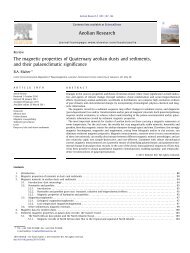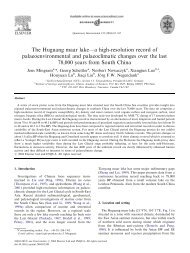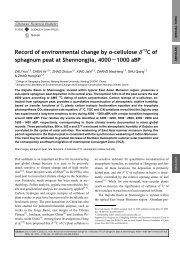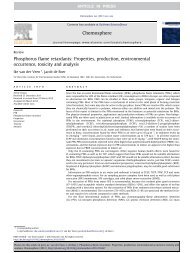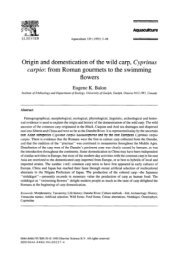Mono- and dicyclic unsaturated triterpenoid hydrocarbons in ...
Mono- and dicyclic unsaturated triterpenoid hydrocarbons in ...
Mono- and dicyclic unsaturated triterpenoid hydrocarbons in ...
You also want an ePaper? Increase the reach of your titles
YUMPU automatically turns print PDFs into web optimized ePapers that Google loves.
884 R. de Mesmay et al. / Organic Geochemistry 39 (2008) 879–893<br />
relative <strong>in</strong>tensity<br />
%<br />
100<br />
50<br />
0<br />
%<br />
100<br />
50<br />
0<br />
%<br />
100<br />
50<br />
0<br />
relative <strong>in</strong>tensity<br />
43<br />
33<br />
71<br />
C 28<br />
125<br />
85 111<br />
H1<br />
C 29<br />
H2<br />
42 44 46 48 retention time (m<strong>in</strong>.)<br />
125<br />
141 167<br />
236/237<br />
211<br />
<strong>and</strong> j are higher homologues of the C34 masokocene c (Figs.<br />
2 <strong>and</strong> 7). The EI mass spectrum of e is consistent with a<br />
C35H60 botryococcene (M +. at m/z 480; Fig. 7A). It exhibits<br />
prom<strong>in</strong>ent fragments at m/z 123 <strong>and</strong> 177, suggest<strong>in</strong>g the<br />
236<br />
294/295<br />
294<br />
446/447<br />
H2<br />
337 386 431 446<br />
M +. -C2H5 50 100 150 200 250 300 350 400 450 m/z<br />
H3<br />
H3<br />
%<br />
100<br />
50<br />
0<br />
H3<br />
H3<br />
C 31<br />
H4<br />
H4<br />
H5<br />
H6<br />
H6<br />
71<br />
85<br />
111<br />
43<br />
236<br />
141<br />
167<br />
197<br />
253<br />
322<br />
295 349 391 435 459 474<br />
69<br />
83<br />
125<br />
139<br />
43<br />
167<br />
236<br />
306<br />
195 277<br />
251 335363389 429 459<br />
125<br />
322/323<br />
474/475<br />
-C2H5 (on C-21)<br />
306/307 277<br />
458/459<br />
139<br />
125<br />
236/237<br />
125<br />
459<br />
H4<br />
236/237<br />
H5<br />
50 100 150 200 250 300 350<br />
M<br />
400 450 m/z 50 100 150 200 250 300 350 400 450 m/z<br />
+. %<br />
100<br />
50<br />
-C2H5 0<br />
M +. -C2H5 43<br />
71<br />
85<br />
111<br />
236<br />
141<br />
167<br />
197<br />
336<br />
267295 363 419 464 488<br />
125<br />
125<br />
236/237<br />
336/337<br />
488/489<br />
H6<br />
69<br />
111<br />
83 139<br />
125<br />
125<br />
153<br />
167<br />
236/237<br />
320/321<br />
472/473<br />
H7<br />
153<br />
473<br />
50 100 150 200 250 300 350 400 450 m/z<br />
43<br />
50 100 150<br />
195 236<br />
251<br />
200 250<br />
M<br />
293<br />
473<br />
320 363 388415<br />
300 350 400 450 m/z<br />
+. M -C2H5 +. %<br />
100<br />
50<br />
-C2H5 0<br />
43<br />
69<br />
83<br />
111<br />
125<br />
139 167<br />
125<br />
209<br />
236<br />
236/237<br />
H7<br />
-CH3 (on C-21)<br />
292/293 277<br />
444/445<br />
H3<br />
292<br />
277<br />
321349 379<br />
M<br />
445<br />
429<br />
+. -C2H5 50 100 150 200 250 300 350 400 450 m/z<br />
Fig. 3. (A) Total ion chromatogram of hydrogenated hydrocarbon fraction from 1856–1871 cm depth sediment <strong>in</strong>terval from Lake Masoko (C xx are<br />
n-alkanes with xx carbon atoms). (B–G) EI mass spectra of botryococcanes H2-H7.<br />
presence of a trimethyl substituted cyclohexenyl r<strong>in</strong>g <strong>in</strong><br />
the left h<strong>and</strong> part of the molecule, as <strong>in</strong> c. The presence<br />
of two r<strong>in</strong>gs <strong>in</strong> e is supported by the mass spectra of the<br />
several diastereomers of C35 botryococcanes H5 formed<br />
125



